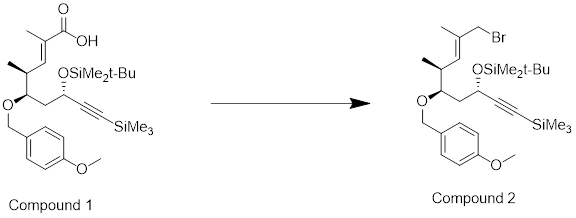
Organic Chemistry
3rd Edition
ISBN: 9781119338352
Author: Klein
Publisher: WILEY
expand_more
expand_more
format_list_bulleted
Question
Chapter 20, Problem 84IP
Interpretation Introduction
Interpretation: An efficient synthesis for the given transformation has to be proposed.
Concept Introduction:
For any given transformation, the following mandatory observations have to be made clear to predict the synthetic scheme:
- Observe whether there is any change in the carbon skeleton.
- Observe whether there is any change in the location of the
functional group . - Predict the synthetic scheme in such a way that these two observations have to be achieved within the minimum chemo selective steps.
The given transformation is:

Reduction with
It is a reducing agent. It reduces
Brominating with
Expert Solution & Answer
Want to see the full answer?
Check out a sample textbook solution
Students have asked these similar questions
Which of the following is true for a particular reaction if ∆G° is -40.0 kJ/mol at 290 K and –20.0 kJ/mol at 390 K?
What is the major product of the following reaction?
O
O
OH
OH
1. BH
2. H₂O₂, NaOH
OH
OH
Draw the products formed when each ester is hydrolyzed with water and sulfuric acid.
Chapter 20 Solutions
Organic Chemistry
Ch. 20.2 - Prob. 1CCCh. 20.2 - Prob. 2CCCh. 20.2 - Prob. 3CCCh. 20.3 - Prob. 4CCCh. 20.3 - Prob. 5CCCh. 20.3 - Prob. 6CCCh. 20.3 - Prob. 7CCCh. 20.3 - Prob. 8CCCh. 20.3 - Prob. 9CCCh. 20.4 - Prob. 10CC
Ch. 20.5 - Prob. 11CCCh. 20.6 - Prob. 12CCCh. 20.6 - Prob. 13CCCh. 20.7 - Prob. 1LTSCh. 20.7 - Prob. 14PTSCh. 20.7 - Prob. 15ATSCh. 20.8 - Prob. 16CCCh. 20.8 - Prob. 17CCCh. 20.8 - Prob. 18CCCh. 20.9 - Prob. 19CCCh. 20.10 - Prob. 20CCCh. 20.10 - Prob. 21CCCh. 20.11 - Prob. 22CCCh. 20.11 - Prob. 23CCCh. 20.12 - Prob. 24CCCh. 20.12 - Prob. 25CCCh. 20.12 - Prob. 26CCCh. 20.13 - Prob. 27CCCh. 20.13 - Prob. 28CCCh. 20.13 - Prob. 29CCCh. 20.14 - Prob. 2LTSCh. 20.14 - Prob. 30PTSCh. 20.14 - Prob. 31ATSCh. 20.14 - Prob. 3LTSCh. 20.14 - Prob. 32PTSCh. 20.14 - Prob. 33ATSCh. 20.15 - Prob. 34CCCh. 20 - Prob. 35PPCh. 20 - Prob. 36PPCh. 20 - Prob. 37PPCh. 20 - Prob. 38PPCh. 20 - Prob. 39PPCh. 20 - Prob. 40PPCh. 20 - Prob. 41PPCh. 20 - Prob. 42PPCh. 20 - Prob. 43PPCh. 20 - Prob. 44PPCh. 20 - Prob. 45PPCh. 20 - Prob. 46PPCh. 20 - Prob. 47PPCh. 20 - Prob. 48PPCh. 20 - Prob. 49PPCh. 20 - Prob. 50PPCh. 20 - Prob. 51PPCh. 20 - Prob. 52PPCh. 20 - Prob. 53PPCh. 20 - Prob. 54PPCh. 20 - Prob. 55PPCh. 20 - Prob. 56PPCh. 20 - Prob. 57PPCh. 20 - Prob. 58PPCh. 20 - Prob. 59PPCh. 20 - Prob. 60PPCh. 20 - Prob. 61PPCh. 20 - Prob. 62PPCh. 20 - Prob. 63PPCh. 20 - Prob. 64PPCh. 20 - Prob. 65PPCh. 20 - Prob. 66PPCh. 20 - Prob. 67PPCh. 20 - Prob. 68PPCh. 20 - Prob. 69PPCh. 20 - Prob. 70IPCh. 20 - Prob. 72IPCh. 20 - Prob. 73IPCh. 20 - Prob. 74IPCh. 20 - Prob. 75IPCh. 20 - Prob. 76IPCh. 20 - Prob. 77IPCh. 20 - Prob. 78IPCh. 20 - Prob. 79IPCh. 20 - Prob. 80IPCh. 20 - Prob. 81IPCh. 20 - Prob. 82IPCh. 20 - Prob. 83IPCh. 20 - Prob. 84IPCh. 20 - Compound 3 (below) was used as an intermediate in...Ch. 20 - The m- and p-substituted methyl benzoates listed...Ch. 20 - Prob. 87IPCh. 20 - Prob. 88IPCh. 20 - Prob. 89IPCh. 20 - Prob. 90CPCh. 20 - Prob. 91CPCh. 20 - Prob. 92CPCh. 20 - Prob. 93CP
Knowledge Booster
Similar questions
- Draw the products of the hydrolysis reaction between the ester molecule and water. Determine the products of the following reaction.arrow_forwardWhat is the unsaturation number for compounds with the formula C₂H₁₂Cl₂? O õ õ o o 4 3arrow_forwardIndicate the product obtained (formula). F3C. CF3 Br NH2 NH OMe K2CO3, DABCO, DMFarrow_forward
- What are the missing intermediates 1, 2, and 3? Please include a detailed explanation explaining the steps of malonic ester synthesis. Please include drawings of the intermediates and how they occur.arrow_forwardThe following intermediates are to proceed by acetoacetic ester synthesis. What are intermediates 1 and 2 plus the final product 3? Please include a detailed explanation and drawings of the intermediates and how they occurred.arrow_forwardThe chemical formula of "benzimidazole E" is C7H6N2. Draw it.arrow_forward
arrow_back_ios
SEE MORE QUESTIONS
arrow_forward_ios
Recommended textbooks for you
 ChemistryChemistryISBN:9781305957404Author:Steven S. Zumdahl, Susan A. Zumdahl, Donald J. DeCostePublisher:Cengage Learning
ChemistryChemistryISBN:9781305957404Author:Steven S. Zumdahl, Susan A. Zumdahl, Donald J. DeCostePublisher:Cengage Learning ChemistryChemistryISBN:9781259911156Author:Raymond Chang Dr., Jason Overby ProfessorPublisher:McGraw-Hill Education
ChemistryChemistryISBN:9781259911156Author:Raymond Chang Dr., Jason Overby ProfessorPublisher:McGraw-Hill Education Principles of Instrumental AnalysisChemistryISBN:9781305577213Author:Douglas A. Skoog, F. James Holler, Stanley R. CrouchPublisher:Cengage Learning
Principles of Instrumental AnalysisChemistryISBN:9781305577213Author:Douglas A. Skoog, F. James Holler, Stanley R. CrouchPublisher:Cengage Learning Organic ChemistryChemistryISBN:9780078021558Author:Janice Gorzynski Smith Dr.Publisher:McGraw-Hill Education
Organic ChemistryChemistryISBN:9780078021558Author:Janice Gorzynski Smith Dr.Publisher:McGraw-Hill Education Chemistry: Principles and ReactionsChemistryISBN:9781305079373Author:William L. Masterton, Cecile N. HurleyPublisher:Cengage Learning
Chemistry: Principles and ReactionsChemistryISBN:9781305079373Author:William L. Masterton, Cecile N. HurleyPublisher:Cengage Learning Elementary Principles of Chemical Processes, Bind...ChemistryISBN:9781118431221Author:Richard M. Felder, Ronald W. Rousseau, Lisa G. BullardPublisher:WILEY
Elementary Principles of Chemical Processes, Bind...ChemistryISBN:9781118431221Author:Richard M. Felder, Ronald W. Rousseau, Lisa G. BullardPublisher:WILEY

Chemistry
Chemistry
ISBN:9781305957404
Author:Steven S. Zumdahl, Susan A. Zumdahl, Donald J. DeCoste
Publisher:Cengage Learning

Chemistry
Chemistry
ISBN:9781259911156
Author:Raymond Chang Dr., Jason Overby Professor
Publisher:McGraw-Hill Education

Principles of Instrumental Analysis
Chemistry
ISBN:9781305577213
Author:Douglas A. Skoog, F. James Holler, Stanley R. Crouch
Publisher:Cengage Learning

Organic Chemistry
Chemistry
ISBN:9780078021558
Author:Janice Gorzynski Smith Dr.
Publisher:McGraw-Hill Education

Chemistry: Principles and Reactions
Chemistry
ISBN:9781305079373
Author:William L. Masterton, Cecile N. Hurley
Publisher:Cengage Learning

Elementary Principles of Chemical Processes, Bind...
Chemistry
ISBN:9781118431221
Author:Richard M. Felder, Ronald W. Rousseau, Lisa G. Bullard
Publisher:WILEY